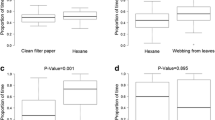Abstract
Survival ofReticulitermes hesperus workers was assessed inPseudotsuga menziesii, Lysiloma seemanii, andTabebuia ochracea sawdusts; and on heartwood solvent extracts ofP. menziesii, L. seemanii, T. ochracea, Pinus ponderosa, Tabebuia guayacan, and aCentrolobium species. Survival inP. menziesii sawdust was 100% at 5 days and 81–87% at 15 days. Survival inL. seemanii andT. ochracea sawdusts was significantly less over both 5 and 15 days than in the starvation control, indicating toxicity. Survival on filter papers treated with solvent extracts ofT. ochracea andP. ponderosa was significantly less than that on control papers, but onlyP. ponderosa differed significantly from the starvation control. In behavioral assays with groups and with individualR. hesperus workers, extracts ofP. menziesii andP. ponderosa were preferred. In the individual behavioral assays, extracts ofT. guayacan andT. ochracea were repellent. Results of toxicity assays were not predictable from preference assays.
Similar content being viewed by others
References
Amburgey, T.L., andSmythe, R.V. 1977. Factors influencing termite feeding on brown-rotted wood.Sociobiology 3:3–12.
Beal, R.H., Carter, F.L., andSouthwell, C.R. 1974. Survival and feeding of subterranean termites on tropical woods.For. Prod. J. 24:44–48.
Becker, G., Lenz, M., andDietz, S. 1972. Unterschiede im Verhalten und der Giftempfindlichkeit verschiedener Termiten-arten gegenüber einigen Kernholzstoffen.Z. Angew. Entomol. 71:201–214.
Bultman, J.D., andSouthwell, C.R. 1976. Natural resistance of tropical American woods to terrestrial wood-destroying organisms.Biotropica 8:71–95.
Bultman, J.D., Beal, R.H., andAmpong, F.F.K. 1979. Natural resistance of some tropical African woods toCoptotermes formosanus Shiraki.For. Prod. J. 29:46–51.
Carter, F.L. 1976. Responses of subterranean termites to wood extractives.Mater. Org. Beih. 3:357–364.
Carter, F.L., andBeal, R.H. 1982. Termite responses to susceptible pine wood treated with antitermitic wood extracts.Int. J. Wood Preserv. 2:185–191.
Carter, F.L., andMauldin, J.K. 1981. Responses ofReticulitermes flavipes to extracts from nine antitermitic hardwoods.Mater. Org. 16:175–188.
Carter, F.L., andSmythe, R.V. 1974. Feeding and survival responses ofReticulitermes flavipes (Kollar) to extractives of wood from 11 coniferous genera.Holzforschung 28:41–45.
Carter, F.L., Stringer, C.A., andSmythe, R.V.. 1972. Survival of six colonies ofReticulitermes flavipes on unfavorable woods.Ann. Entomol. Soc. Am. 65:984–985.
Carter, F.L., Jones, S.C., Mauldin, J.K., andde Camargo, C.R.R. 1983. Responses ofCoptotermes formosanus Shiraki to extracts from five Brazilian hardwoods.Z. Angew. Entomol. 95:5–14.
Dixon, W.J., andMassey, F.J. 1983. Introduction to Statistical Analysis. McGraw-Hill, New York, 678 pp.
Ebeling, W. 1975. Urban Entomology. University of California Division of Agricultural Science. 695 pp.
Esenther, G.R., andBeal, R.H. 1979. Termite control: Decayed wood bait.Sociobiology 4:215–222.
Frankie, G.W., Baker, H.G., andOpler, P.A. 1974. Comparative phenological studies of trees in tropical wet and dry forests in the lowlands of Costa Rica.J. Ecol. 62:881–919.
Frankie, G.W., Haber, W.A., Opler, P.A., andBawa, K.S. 1983. Characteristics and organization of the large bee pollination system in the Costa Rican dry forest, pp. 411–447,in C.E. Jones and R.J. Little (eds.). Handbook of Experimental Pollination Biology. Van Nostrand Reinhold, New York.
Grace, J.K. 1986. A simple humidity chamber for maintaining subterranean termites (Isoptera: Rhinotermitidae) in the laboratory.Pan-Pac. Entomol. 62:221–223.
Harlow, W.M., Harrar, E.S., andWhite, F.M. 1979. Textbook of Dendrology. McGraw-Hill, New York. 510 pp.
Jurd, L., andWong, R.Y. 1984. Diarylheptanoid and other phenolic constituents ofCentrolobium species.Aust. J. Chem. 37:1127–1133.
Kofoid, C.A., andBowe, E.E. 1934. Biological tests of untreated and treated woods, pp. 517–544,in C.A. Kofoid (ed.). Termites and Termite Control. University of California Press, Berkeley.
Kukachka, B.F. 1970. Properties of imported tropical woods. USDA Forest Service, Research Paper FPL 125.
Lenz, M. 1985. Variability of vigour between colonies ofCoptotermes acinaciformis (Froggatt) (Isoptera: Rhinotermitidae) and its implications for laboratory experimentation.Bull. Entomol. Res. 75:13–21.
Rust, M.K., andReierson, D.A. 1977. Using wood extractives to determine feeding preferences of the western drywood termite,Incisitermes minor (Hagen).J. Chem. Ecol. 3:391–399.
Sandermann, W., andDietrichs, H.H. 1957. Untersuchungen über termitenresistente Hölzer.Holz Roh-Werk. 15:281–297.
SAS Institute. 1982. SAS User's Guide: Statitics. SAS Institute Inc., Cary, North Carolina. 584 pp.
Sen-Sarma, P.K. 1986. Economically important termites and their management in the Oriental region, pp. 69–102,in S.B. Vinson (ed.). Economic Impact and Control of Social Insects. Praeger, New York.
Smythe, R.V., andCarter, F.L. 1970. Survival and behavior of three subterranean termite species in sawdust of eleven wood species.Ann. Entomol. Soc. Am. 63:847–850.
Su, N.-Y., andLaFage, J.P. 1984. Differences in survival and feeding activity among colonies of the Formosan subterranean termite (Isoptera, Rhinotermitidae).Z. commercially Angew. Entomol. 97:134–138.
Su, N.-Y., andTamashiro, M. 1986. Wood-consumption rate and survival of the Formosan subterranean termite (Isoptera: Rhinotermitidae) when fed one of six woods used commercially in Hawaii.Proc. Hawaii. Entomol. Soc. 26:109–113.
Varma, R.V., Reghunandanan, V.R., andAmbika, B. 1984. Response of the subterranean termiteOdontotermes guptai (Isoptera: Termitidae) to extracts of eucalypt root and certain other plant materials.Mater. Org. 19:283–290.
Weesner, F.M. 1965. The Termites of the United States—A Handbook. National Pest Control Association, New Jersey. 70 pp.
Wolcott, G.N. 1950. An index to the termite-resistance of woods. University of Puerto Rico, Agriculture Experiment Station Bulletin 85. 26 pp.
Wolcott, G.N. 1924. The comparative resistance of woods to the attack of the termite,Cryptotermes brevis Walker. P.R. Insular Experiment Station Bulletin. 33. 15 pp.
Author information
Authors and Affiliations
Rights and permissions
About this article
Cite this article
Kenneth Grace, J., Wood, D.L. & Frankie, G.W. Behavior and survival ofReticulitermes hesperus banks (Isoptera: Rhinotermitidae) on selected sawdusts and wood extracts. J Chem Ecol 15, 129–139 (1989). https://doi.org/10.1007/BF02027779
Received:
Accepted:
Issue Date:
DOI: https://doi.org/10.1007/BF02027779




